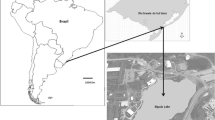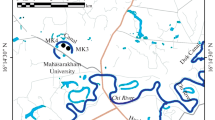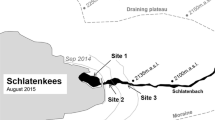Abstract
This paper summarizes the results of our long-term research (2007–2015) of chironomids in 38 saline and hypersaline lakes of Crimea. Chironomid larvae were found at salinities up to 340 g/L, and the frequency of their occurrence decreased as salinity rose above 30–50 g/L. We identified four species, namely, Baeotendipes noctivagus, Cricotopus gr. cylindraceus, Tanytarsus gr. Mendax, and Paratanytarsus gr. quantuplex. The numbers of chironomid larvae varied within wide limits and peaked at the levels of up to 8000/m3 in plankton, up to 9000/m2 in the benthos, and up to 3000/m2 on the floating mats of filamentous green algae. The abundance, biomass, and production of larvae were nonlinearly dependent on the salinity. A salinity increase led to a decreased number of species and reduced average sizes. The maximum values were observed within 150–170 g/L.




Similar content being viewed by others
REFERENCES
Alimov, A.F., Relations between biological diversity in continental waterbodies and their morphometry and water mineralization, Inland Water Biol., 2008, vol. 1, no. 1, pp. 1–6.
Anufriieva, E.V., Cyclopoida in hypersaline waters of the Crimea and the world: diversity, the impact of environmental factors, ecological role, Zh. Sib. Feder. Univ., Ser. Biol., 2016, vol. 9, no. 4, pp. 398–408.
Anufriieva, E., Holynska, M., and Shadrin, N., Current invasions of Asian cyclopid species (Copepoda: Cyclopidae) in Crimea, with taxonomical and zoogeographical remarks on the hypersaline and freshwater fauna, Annales Zoologici, 2014, vol. 64, no. 1, pp. 109–130.
Anufriieva, E.V., Do copepods inhabit hypersaline waters worldwide? A short review and discussion, Chin. J. Oceanol. Limnol., 2015, vol. 33, no. 6, pp. 1354–1361.
Armitage, P.D., Pinder, L.C., and Cranston, P., The Chironomidae: Biology and Ecology of Nonbiting Midges, London: Springer Science and Business Media, 1995.
Balushkina, E.V., The functional significance of chironomid larvae in inland water bodies, Tr. Zool. Inst. Akad. Nauk SSSR, 1987, vol. 142, p. 185.
Balushkina, E.V. and Petrova, N.A., Functioning of chironomid populations in hypersaline lakes of the Crimea, Tr. Zool. Inst. Akad. Nauk SSSR, 1989, vol. 205, pp. 129–138.
Balushkina, E.V., Golubkov, S.M., Golubkov, M.S., Litvinchuk, L.F., and Shadrin, N.V., The influence of abiotic and biotic factors on the structural and functional organization of the ecosystems of salt lakes of the Crimea, Zh. Obshch. Biol., 2009, vol. 70, no. 6, pp. 504–514.
Belmonte, G., Moscatello, S., Batogova, E.A., Pavlovskaya, T., Shadrin, N.V., and Litvinchuk, L.F., Fauna of hypersaline lakes of the Crimea (Ukraine), Thalassia Salentina, 2012, vol. 34, pp. 11–24.
Cartier, V., Claret, C., Garnier, R., and Franquet, E., How salinity affects life cycle of a brackish water species, Chironomus salinarius Kieffer (Diptera: Chironomidae), J. Exp. Mar. Biol. Ecol., 2011, vol. 405, no. 1, pp. 93–98.
Cornette, R. and Kikawada, T., The induction of anhydrobiosis in the sleeping chironomid: current status of our knowledge, IUBMB Life, 2011, vol. 63, no. 6, pp. 419–429.
El-Shabrawy, G.M. and El Sayed, T.R., Long-term changes and community structure of macrobenthic arthropoda and mollusca in Bardawill lagoon, Thalassia Salentina, 2005, vol. 28, pp. 17–30.
Hirvenoja, M., Revision der Gattung Cricotopus van der Wulp und ihrer Verwandten (Diptera, Chironomidae), Ann. Zool. Fenn., 1973, vol. 10, no. 1, pp. 1–363.
Khlebovich, V.V. and Aladin, N.V., Salinity factor in the life of animals, Vestn. Ross. Akad. Nauk, 2010, vol. 80, no. 5–6, pp. 527–532.
Kokkinn, M.J., Osmoregulation, salinity tolerance and the site of ion excretion in the halobiont chironomid, Tanytarsus barbitarsis Freeman, Aust. J. Mar. Freshwater Res., 1986, vol. 37, no. 2, pp. 243–250.
Kokkinn, M.J., Is the rate of embryonic development a predictor of overall development rate in Tanytarsus barbitarsis Freeman (Diptera: Chironomidae)?, Aust. J. Mar. Freshwater Res., 1990, vol. 41, no. 5, pp. 575–579.
Litvinenko, N.M. and Shlyakhov, V.A., The state of the stock of chironomid larvae in inland saline water bodies of Crimea, Tr. YugNIRO, 2011, vol. 49, pp. 84–90.
Makarchenko, E.A. and Makarchenko, M.A., Chironomidae. Midges, in Opredelitel’ presnovodnykh bespozvonochnykh Rossii i sopredel’nykh territorii. Vysshie nasekomye. Dvukrylye (Identification Guide to Freshwater Invertebrates of Russia and Adjacent Countries: Higher Insects. Diptera), Zool. Inst. Ross. Akad. Nauk, St. Petersburg, 1999, vol. 4, pp. 210–297.
Moscatello, S. and Belmonte, G., Egg banks in hypersaline lakes of the South-East Europe, Saline Systems, 2009, vol. 5, no. 1, pp. 1–7.
Müller, P.H., Neuman, P., and Storm, R., Tafeln der mathematischen Statistik, VEB Leipzig: Fachbuchverlag, 1979.
Nicacio, G. and Juen, L., Chironomids as indicators in freshwater ecosystems: an assessment of the literature, Insect Conserv. Diversity, 2015, vol. 8, no. 5, pp. 393–403.
Pankratova, V.Ya., Lichinki i kukolki komarov podsemeistva Orthocladiinae fauny SSSR (Larvae and Pupae of Mosquitoes of the Subfamily Orthocladiinae of the Fauna of the USSR), Leningrad: Nauka, Leningr. Otd., 1970.
Pankratova, V.Ya., Lichinki i kukolki komarov podsemeistva Chironominae fauny SSSR (Larvae and Pupae of Mosquitoes of the Subfamily Chironominae of the Fauna of the USSR), Leningrad: Nauka, Leningr. Otd., 1983.
Patrick, M.L. and Bradley, T.J., Regulation of compatible solute accumulation in larvae of the mosquito Culex tarsalis: osmolarity versus salinity, J. Exp. Biol., 2000, vol. 203, pp. 831–839.
Renault, D., Lombard, M., Vingere, J., and Laparie, M., Comparative salinity tolerance in native flies from the subantarctic Kerguelen islands: a metabolomic approach, Polar Biol., 2016, vol. 39, no. 1, pp. 47–56.
Shadrin, N.V. and Anufriieva, E.V., Climate change impact on the marine lakes and their crustaceans: the case of marine hypersaline Lake Bakalskoye (Ukraine), Turk. J. Fish. Aquat. Sci., 2013a, vol. 13, no. 4, pp. 603–611.
Shadrin, N. and Anufriieva, E., Dependence of Arctodiaptomus salinus (Calanoida, Copepoda) halotolerance on exoosmolytes: new data and a hypothesis, J. Mediterr. Ecol., 2013b, vol. 12, pp. 21–26.
Shadrin, N.V., Anufriieva, E.V., Amat, F., and Eremin, O.Y., Dormant stages of crustaceans as a mechanism of propagation in the extreme and unpredictable environment in the Crimean hypersaline lakes, Chin. J. Oceanol. Limnol., 2015, vol. 33, no. 6, pp. 1362–1367.
Shadrin, N.V., Sergeeva, N.G., Latushkin, A.A., Kolesnikova, E.A., Kipriyanova, L.M., Anufriieva, E.V., and Chepyzhenko, A.A., Transformation of Gulf Sivash (the Sea of Azov) in conditions of growing salinity: changes of meiobenthos and other ecosystem components (2013–2015), Zh. Sib. Fed. Univ., Ser. Biol., 2016, vol. 9, no. 4, pp. 452–466.
Shadrin, N.V., Anufriieva, E.V., Belyakov, V.P., and Bazhora, A.I., Chironomidae larvae in hypersaline waters of the Crimea: diversity, distribution, abundance and production, Eur. Zool. J., 2017, vol. 84, no. 1, pp. 61–72.
Suemoto, T., Kawai, K., and Imabayashi, H., A comparison of desiccation tolerance among 12 species of chironomid larvae, Hydrobiologia, 2004, vol. 515, pp. 107–114.
Suworow, E.K., Zur Beurteilung der lebenserscheinungen in gestatigten salzseen, Zool. Anz., 1908, vol. 32, pp. 647–674.
Szadziewski, R. and Hirvenoja, M., Cricotopus zavreli sp. n. (diptera, chironomidae), a halobiontic non-biting midge from Poland, Ann. Entomol. Fenn., 1981, vol. 47, no. 4, pp. 111–118.
Wiederholm, T., Chironomidae of the Holarctic Region: keys and diagnoses, Part 1: Larvae, Entomol. Scand. Suppl., 1983, vol. 19, p. 457.
Zagorodnyaya, Yu.A., Batogova, E.A., and Shadrin, N.V., Long-term transformation of the plankton in the hypersaline Lake Bakalskoye (Crimea) at salinity fluctuations, Morsk. Ekol. Zh., 2008, vol. 7, no. 4, pp. 41–50.
Zawierucha, K., Kolicka, M., Takeuchi, N., and Kaczmarek, L., What animals can live in cryoconite holes? A faunal review, J. Zool., 2015, vol. 295, no. 3, pp. 159–169.
ACKNOWLEDGMENTS
We thank O.Yu. Eremin for his support in organizing the field work and E.A. Galagovets for assistance in processing the samples.
Author information
Authors and Affiliations
Corresponding author
Additional information
Translated by E. Kuznetsova
Rights and permissions
About this article
Cite this article
Belyakov, V.P., Anufriieva, E.V., Bazhora, A.I. et al. Effect of Salinity on Chironomid Larvae (Diptera, Chironomidae) in Hypersaline Lakes of Crimea. Biol Bull Russ Acad Sci 45, 1211–1218 (2018). https://doi.org/10.1134/S1062359018100059
Received:
Published:
Issue Date:
DOI: https://doi.org/10.1134/S1062359018100059




